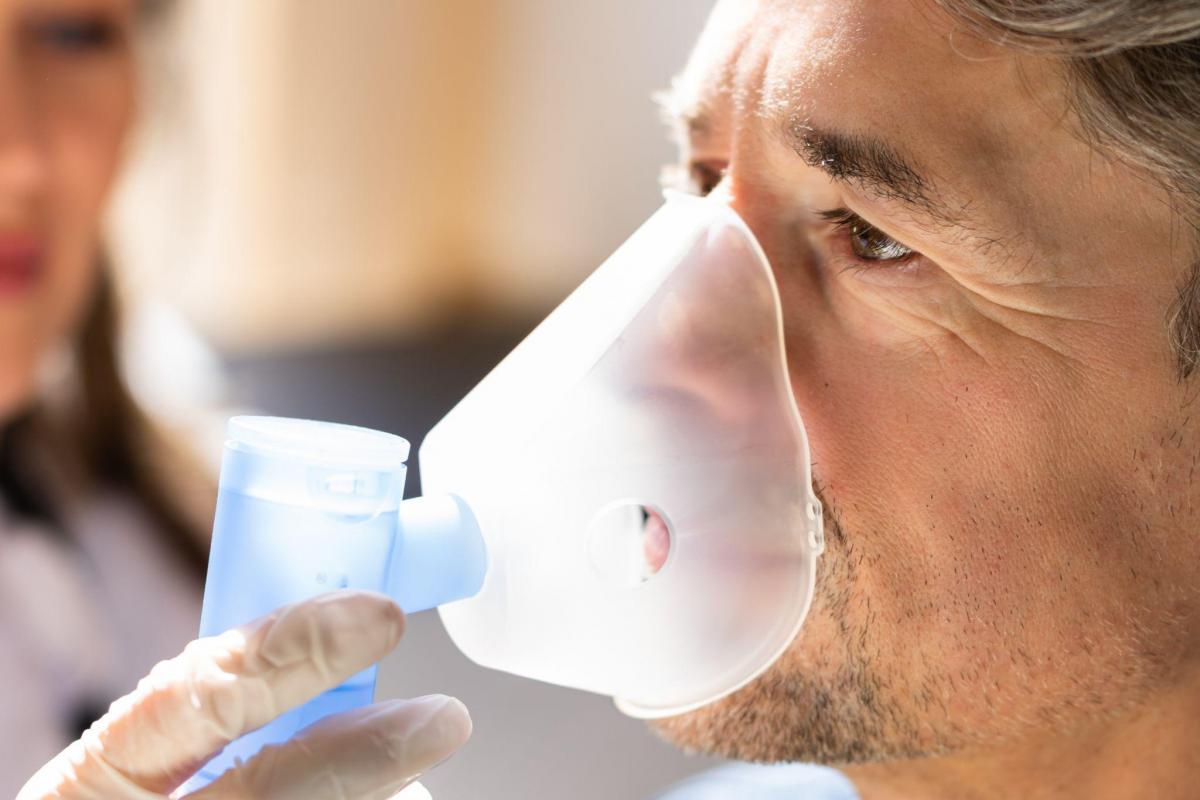Chronic obstructive pulmonary disease or COPD refers to one or more chronic respiratory conditions that affect millions of Americans. Unfortunately, millions more struggle with COPD symptoms but go without treatment because the condition is often underdiagnosed.1 Learn more about COPD’s causes, symptoms, treatments, and management strategies, as well as how the Pulmonary and Critical Care Medicine team at Crystal Run Healthcare can help you manage your COPD symptoms.
Understanding COPD: an Introduction to Its Causes and Symptoms
COPD is a term to describe a large group of chronic lung diseases that cause airflow limitation (less air in and out of the airways) and breathing-related symptoms, such as Emphysema, chronic bronchitis, and other respiratory conditions. Since many chronic respiratory diseases are classified as COPD, COPD can have several causes, including both environmental and hereditary. The inhalation of tobacco smoke is the main cause, but other air pollutants like vehicle and chemical fumes can also cause the condition to develop.2
Other reasons people can develop COPD are because of a family history of COPD, contracting pneumonia or another respiratory condition, or even having a genetic disorder that affects the health of your lungs.
The common symptoms of COPD include:
- Shortness of breath
- Frequent wheezing or coughing
- Chest tightness
- Trouble or inability to take a deep breath
- Excess mucus or phlegm
Other signs of COPD include excessive fatigue, increasing difficulty with walking up stairs or running errands, and experiencing frequent colds. Since COPD is a progressive disease, meaning it will get worse over time, it is important to see a provider for COPD testing.
Diagnosing COPD
In order to get a COPD diagnosis, a provider will most often test for COPD through a method called spirometry. During the spirometry test, a technician will ask you to take as deep a breath as you can, and then blow as hard and long as you can into a tube connected to a small machine. You may be given a medicinal inhalant to open up your airways and be asked to perform the test again. Your provider can then compare your test results before and after taking the medicine. This test allows your provider to measure how much oxygen you can breathe in and out to establish baseline health or diagnose the severity of your COPD.
A pulmonologist may perform extensive testing through Pulmonary Function testing, oxygen evaluations like a 6-minute walk test, or Chest CT imaging, to fully check your lung health and capacity, as well as diagnose any additional health complications that may be contributing to your COPD. Crystal Run Healthcare offers onsite Pulmonary Function Testing (PFT) services in several locations in the Hudson Valley.
Breathing Techniques and Rehabilitation: Enhancing Lung Function
Lung function and capacity can be greatly reduced by COPD, which causes airway inflammation and damage to the alveoli (air sacs) in the lungs and the bronchial tubes. Certain breathing techniques and rehabilitation strategies can enhance lung function and decrease lung damage, making it easier to breathe and maintain healthy lungs. If you have been diagnosed with COPD or have a family history of COPD, your provider may discuss breathing techniques or rehabilitation to increase your lung function.
Belly Breathing
The diaphragm is the organ that allows for healthy breathing to take place. Belly breathing, also called diaphragmatic breathing, helps to strengthen the diaphragm, which is often weakened in those with COPD. The steps for belly breathing are as follows:
- Lie down or sit with your shoulders relaxed.
- With one hand on the chest and the other on the belly, inhale through the nose for two seconds and feel the air enter the abdomen and move the stomach out.
- Purse the lips and exhale for four to six seconds.
Place a box of tissues on your belly as you inhale and exhale. Keep your neck and shoulders relaxed while breathing and allow the diaphragm to do the work.
Pursed Lip Breathing
Breathing through pursed lips keeps the airways open longer, allowing more air in and out. It also reduces the number of breaths you take.
- Inhale through the nose for as many seconds as is tolerable.
- Purse the lips and exhale for at least twice as long as you inhaled.
Rehabilitation
Pulmonary rehabilitation is an individualized combination of education, counseling, physical exercise, and breathing techniques that are aimed at relieving the symptoms of COPD, reducing the risk of other respiratory problems, and improving quality of life.
A rehabilitation program will educate about COPD and treatment options like oxygen and medication. It will also include supervised exercise sessions and instruction on breathing techniques.
The National Heart, Lung, and Blood Institute’s Breathe Better program helps people better understand lung diseases like COPD. They also offer webinars, toolkits, and materials for patients, caregivers, and health professionals.
Nutritional counseling will help patients maintain a healthy weight; too much extra weight can make breathing difficult. Nutritional counseling also corrects vitamin and mineral imbalances that can negatively affect lung function.
Individual counseling is an important part of pulmonary rehabilitation because many people with COPD also struggle with anxiety, depression, and other issues.
At Crystal Run Healthcare, our board-certified pulmonary medicine specialists have a thorough understanding of lung and heart function. Combining state-of-the-art medical equipment and a team approach to healthcare, we work closely with our cardiologists, vascular surgeons, and other specialists to provide precise diagnoses and the most effective treatments available.
Treatment Options and Advancements: from Medications to Oxygen Therapy

Inhalers work to prevent tightening of the bronchial muscles and reduce mucus. These can be long-acting to control daily symptoms or short-acting for fast relief of acute breathing difficulties.
Some oral medications aim to reduce inflammation in the airways for those with severe COPD, while antiviral or antibiotic medications may help prevent respiratory infections and further damage to the lungs and airways.
COPD can result in insufficient oxygen levels in the body, which can lead to symptoms like dizziness and confusion, as well as the development of other serious diseases. Oxygen therapy delivers oxygen directly to the nose or mouth, increasing oxygen levels and eliminating symptoms, allowing patients to maintain their quality of life.
Advancements include stem cell therapy, IL-5 medications, and biologics, but these treatments are not yet available for those with COPD. Natural treatments include reflexology and the inhalation of essential oils like peppermint and ginger, which can help open the airways and decrease inflammation.
Living with COPD: Lifestyle Adjustments and Management Tips
The following lifestyle adjustments and management tips can keep patients healthy and reduce COPD symptoms:
Lifestyle Adjustments
Speak with your provider about annual preventative vaccinations against respiratory infections and diseases. The Centers for Disease Control and Prevention considers flu and pneumonia vaccines to be beneficial for those with COPD.
For those who smoke, quitting is the first step to living with COPD. Patients who smoke and are diagnosed with COPD should consult with their doctor for information about smoking cessation.
There are also environmental changes someone with COPD can make. Cleaning or reducing the number of carpets and other household fabrics regularly will help reduce the amount of air pollutants in the home. Installing an air purifier that uses a HEPA filter will also help to keep rooms clear of dust and detritus.
Walking and practicing breathing exercises daily has significant benefits. Both types of exercise have been shown to improve physical and mental health, as well as improve the travel and delivery of oxygen to the muscles and blood, making it easier to breathe.
COPD Management Tips
It’s important to rest when the body needs to, as this will help with recovery and stamina. Being consistent with breathing and physical exercise will help to slow the progression of the disease and maintain lung function over the long term.3
Crystal Run’s Pulmonary Care Excellence: Tailored Treatment and Ongoing Support

Pulmonary & Critical Care Medicine at Crystal Run Healthcare provides COPD patients with specialized treatment using advanced diagnostics. Our pulmonary medicine specialists are board-certified, working together to provide comprehensive care that’s always close to home. Visit us for helpful resources or call 845-703-6999 to book your appointment.
Sources:
